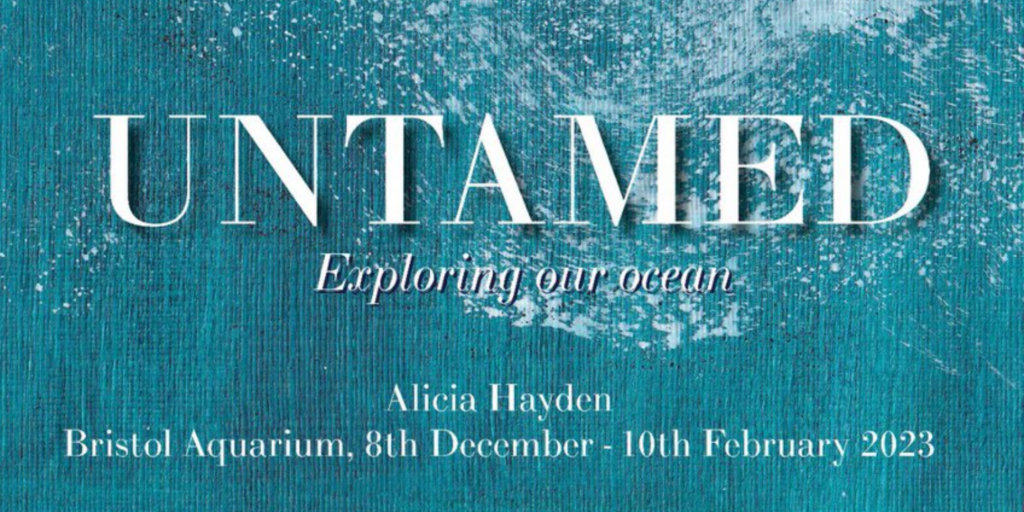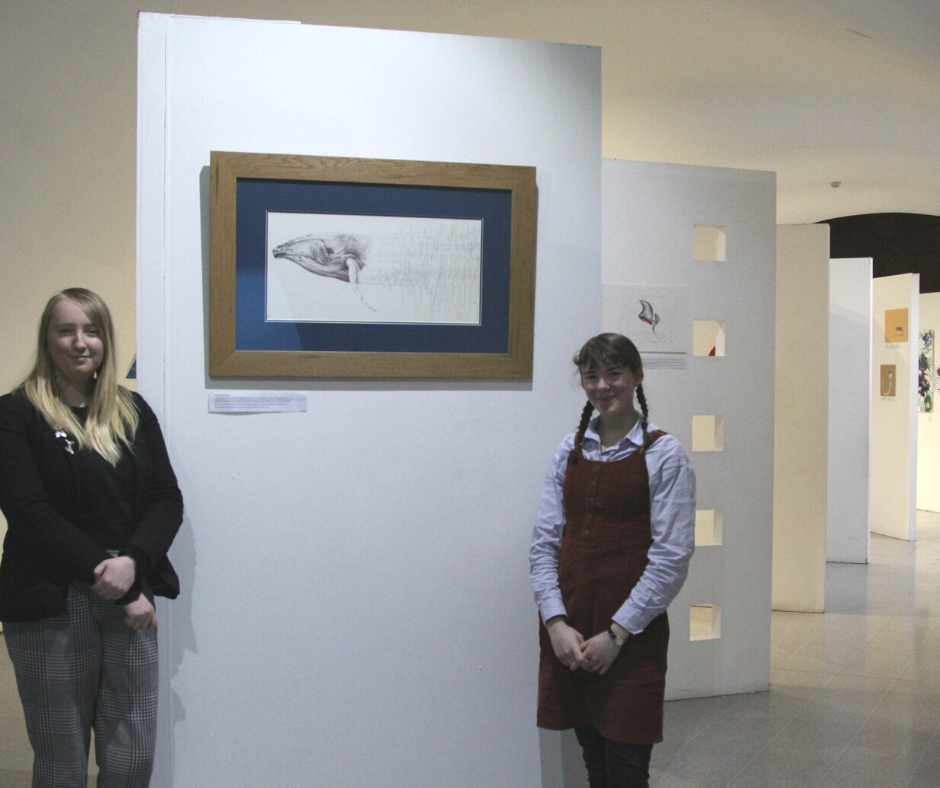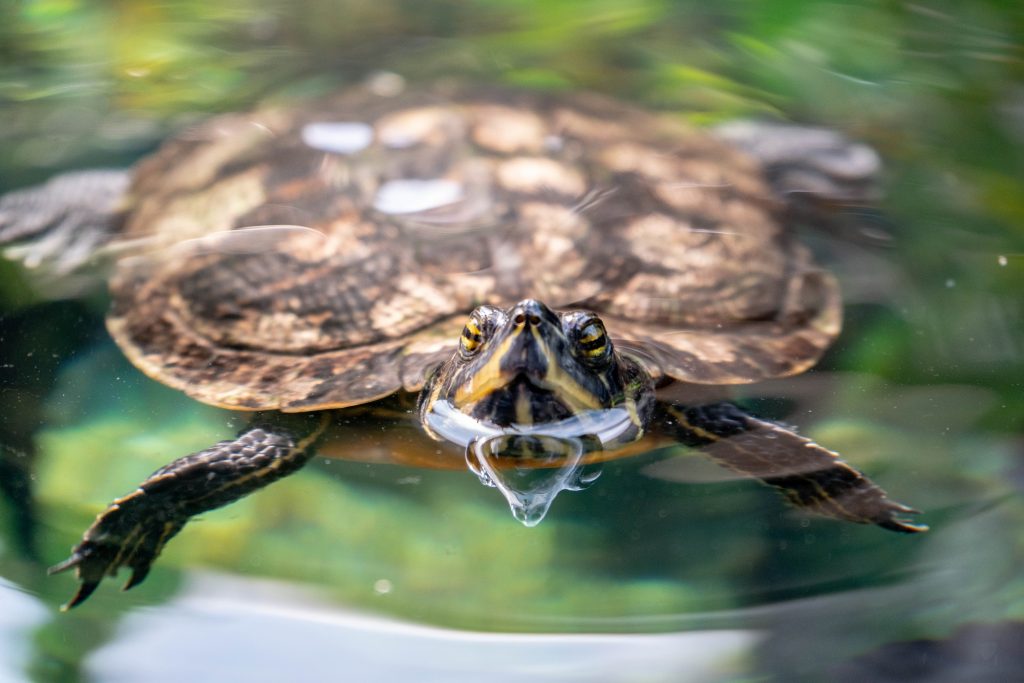Award-winning wildlife artist Alicia Hayden makes a powerful statement at Bristol Aquarium. Untamed, started on Thursday 8th of December. Visitors will flock for 2 months to see the moving pieces of art.
The focus of Alicia’s art is marine life. Untamed uses art to explore our oceans – wild, untamed, and unexplored ecosystems, which are increasingly under threat from us.
The exhibition will showcase around 35 art pieces, primarily exploring marine artivism as well as pieces that showcase the wider natural world.
We caught up with Alicia to ask her a couple of questions about Untamed!

Why did you want to exhibit Untamed at Bristol Aquarium?
In October Chloe, [Chloe O’Dell, Operations Supervisor – Catering and Functions at Bristol Aquarium] and I were chatting about the importance of engaging people with marine life and conservation through art. I mentioned that I had several pieces exploring marine wildlife, and Chloe was excited about the prospect of putting together an exhibition together at the aquarium!
When putting together “Untamed”, I wanted to focus on marine life, but include some pieces from the wider natural world. As I was curating the exhibition off the back of my first solo wildlife art exhibition “Exploring Artivism”, it was important to me that “Untamed” felt like it was building on some of the areas explored previously – namely artivism – as well as introducing new concepts and artworks.
Do you have a favourite piece that is on display at Bristol Aquarium?
That’s such a difficult question! I think all of my pieces have been favourites at some point, and I think whenever I first finish a piece, that artwork automatically becomes my favourite for a while. Having said this, I think I have three pieces which I really love at the Bristol Aquarium:
“Losing their Spot” is one of my most recent pieces – I started drawing cheetahs regularly when producing animations for my short film “The Watchman”; since then I’ve enjoyed exploring cheetahs in my artwork too. I loved painting “Losing their Spot” as I found working on a round canvas really fun, and I enjoyed using bright colours to draw attention to the piece.
I also really love “The Slow Dance”. As it’s such a big piece, consisting of 8 A2 panels, I’d not seen it up before exhibiting it, so it’s been a really special experience finally seeing it come together.
And of course, “When the Whale Sang” has a really special place in my heart, as a pivotal piece which gave me the confidence to delve into artistic science communication and artivism.

‘When the Whale Sang.’ Won the ‘Human Impact’ category in David Shepherd Wildlife Artist of the year 2021. Can you tell us what inspired this piece and the message exploring marine life you hope people will take away from it?
“When the Whale Sang” was created in June 2020 using biro – I was doing the British Ecological Society (BES)’s undergraduate summer school, and one of our assignments was to write a blog post communicating a scientific research paper. I decided to do mine on how noise pollution affects cetaceans, as it’s an issue which has always fascinated me; filmmaker Annie Moir create a beautiful short film “A Voice above Nature” which explored this area – she visualised noise pollution in her film, and I thought this was a really different approach!
I knew that I wanted to illustrate my blog post as part of the summer school, and I had recently been exploring the work of Martin Aveling, and was particularly struck by a beautiful artivism piece of his where a tiger turns into a barcode, reflecting the fur trade. So the piece was a combination of inspiration from the BES, Annie, and Mart!
The aim of the piece is to illustrate the effect noise pollution has on cetaceans such as humpback whales. Anthropogenic marine noise pollution affects their communication, meaning they struggle to navigate, find food, avoid predators, and locate potential mates. Noise pollution is caused by everything from fishing practises to military sonar, and it is an issue which is all too often overlooked due to its invisible nature – so I hope that by visualising the noise pollution in a dramatic but beautiful way, it will provoke people to think about this issue, and focus on what we can do to tackle it.

Why did you decide to study Biological Sciences at Oxford university?
I’ve wanted to work in the wildlife film industry since I was about 13, and so I wanted to study Biology, as I thought this would be the best foundation for me to do this. Additionally, I love Biology – specifically zoology, ecology, conservation, and ornithology – so I wanted to study it in-depth at degree level! Studying at Oxford has also always been an aspiration of mine. I liked the collegiate aspect of the university, and the fact the degree encourages and hones your writing skills through essays. I love writing and the arts – so the course at Oxford allowed me to incorporate these skills as much as possible within the science degree.
Studying a Master’s in Wildlife Filmmaking at UWE Bristol, have you been inspired by the nature at Bristol at all?
Absolutely! I used to live in Frenchay, so I was surrounded by wildlife – kingfishers, green woodpeckers, jays, foxes, buzzards, and lots of warblers and smaller bird species! Wildlife and nature can be very therapeutic and relaxing, as well as deeply inspiring. Often, I come back with art and writing ideas after walking in nature. Most notably, my illustrated poetry mini-collections are all inspired by the nature I’ve encountered on my doorstep – be that in Bristol or elsewhere. My most recent collection “Sing for me, your sweet, sweet song” was inspired by the birds I used to hear singing on Frenchay Moor.
Your exhibition ‘Untamed’ explores our ocean and marine life. What do you think the biggest challenge is for creatures of the deep?
There are lots of issues facing our marine and ocean life, and deep-sea species are no exception. Deep sea mining is one of the most prominent threats, causing habitat destruction, pollution, and noise pollution; as well as climate change causing warming waters around the globe. Chemical pollutants and oil spills are hugely damaging to marine life, suffocating reefs and mangroves, and dooming marine life to slow deaths. The biggest challenge faced for all marine life is humans – and our multi-pronged impact on their ecosystems.
Art is a powerful tool that gets important messages across in a creative way. What do you hope to achieve with ‘Untamed’?
I hope that “Untamed” makes people stop and think about our oceans. So often we forget about our seas – but they are our biggest form of carbon storage, home to over 240,000 known species, and over 80% unexplored. We have so much to learn from our wild, untameable ocean – and I hope that “Untamed” reflects this.
You can come to Bristol Aquarium to view ‘Untamed’ until the 10th of February. You do not need to buy a ticket to enter Bristol Aquarium to see Alicia’s artwork.

